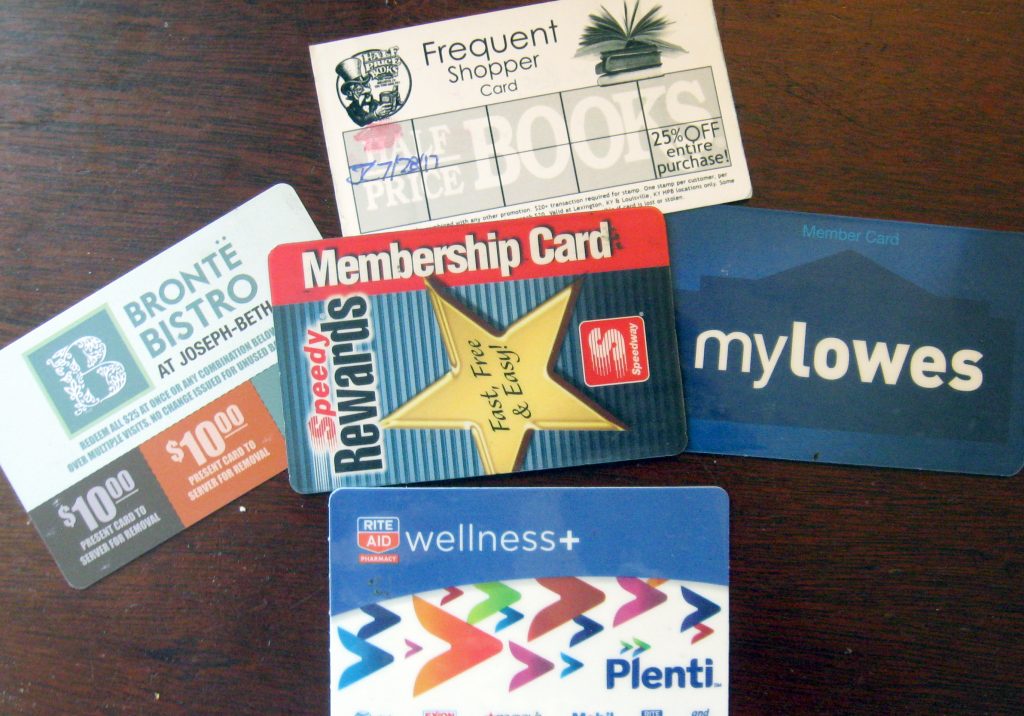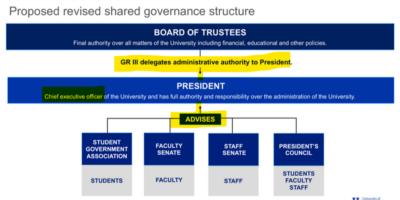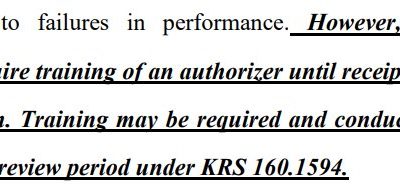About a year ago, while still employed as a part-time faculty member at Bluegrass Community & Technical College, I received an email from the office of Dr. Jay Box, the then-new president of the Kentucky Community & Technical College System. The email contained a link to a video, in which Dr. Box described a new initiative whereby students who successfully completed a semester of 15 credit hours, then enrolled in a second semester of 15 credit hours, would receive a $500 credit toward their tuition: a tuition-free class, approximately, as a reward for a year of full-time enrollment.
Or, put another way: buy nine, get one free, like a customer loyalty reward scheme at your local coffee or sandwich shop. This is a time-tested strategy for customer retention: incentives for frequent purchases. In my own wallet I have a Speedway loyalty card with tens of thousands of accumulated “Speedy” points, convertible to free coffee, gift cards, and even discounted gasoline. And I’d be lying if I said the promise of these rewards has no influence on which convenience store I patronize, and where I fill up my car. I want those points. They keep me coming back.

So any business that sees value in customer retention, as any competently managed business should, might choose to institute such a program. These programs do work quite well, even if you think Speedway coffee, for instance, is just okay.
In fact, customer participation in loyalty schemes such as Speedway’s is rarely a reflection of the quality of the products or services on offer; the effectiveness of these programs often outweigh quality considerations in the minds of consumers. For example, the major airlines always fare poorly in national surveys of customer satisfaction, but the high-value rewards of their frequent-flier programs (along with regional near-monopolies) are generally sufficient incentive to keep their customers buying tickets. You may come to despise United for the delays, cancellations, and cramped seats, but with a first-class upgrade in sight, you’ll keep flying the friendly skies.
Frequent-buyer programs aren’t the only way to achieve customer retention. Some companies choose to focus on ensuring the satisfaction and retention of their own employees, reasoning that customers will more likely return if they see a familiar face, or hear a familiar voice. Many companies have chosen this method of retaining customers; in the business of musical instrument retail, for example, Sweetwater has chosen to compete with Guitar Center, Musician’s Friend, Amazon, and the rest by assigning a personal “sales engineer” to each customer, who provide purchasing advice and, often, friendly conversation, via telephone. Sweetwater’s prices may or may not be lower than their competitors’, but they believe that customers will more likely buy again from someone they’ve come to know on a first-name basis.
Of course, the most obvious method of retaining customers is by providing them with products and services of the best quality in a given price range. This strategy is often the surest route to creating brand loyalty among customers: years ago, my father bought his first Toyota, after having owned a string of Detroit-made cars. He found that he liked the quality of the Toyota so much that he continued to buy them for the next decade, trading in the old one every two or three years, without so much as test-driving another car make. He wasn’t alone: better quality for the money made Toyota one of the best-selling car manufacturers in the world.

Let’s go back to college. In starting the free-class scheme, Dr. Box and KCTCS had chosen to use the frequent-buyer model of customer retention: buy nine classes, get your tenth free. This makes some sense, even if you initially recoil at the idea of an institution of higher learning adopting the same marketing strategies as a chain of convenience stores. The pool of potential students—er, customers—at a community college is one more affected by factors contributing to dropping out of school than most four-year colleges. At BCTC, for instance, a great proportion of customers have a relatively poor record of academic achievement, and perhaps enroll after high school for the lack of something better to do; others want the degree desperately, but don’t have the financial resources to see it through; still others are working adults, for whom the demands of work and family interfere with re-enrollment and degree completion. A free class, then, could be exactly what these customers need to keep coming back.
Despite these factors, I was irritated with Dr. Box’s email, so I replied to it: “Since we have the money to give away free classes now, will we also see a raise for part-time faculty?” To my surprise, he replied personally to inform me that faculty wages were set at the college level, and that my concerns were better addressed to Dr. Augusta Julian, the then-president of BCTC. So I did, and many more emails and six months later, I was summoned to a meeting with Dr. Koffi Akakpo, who’d just replaced Dr. Julian as BCTC President, and Dr. Greg Feeney, a long-serving VP.
They wanted to hear my concerns in person, and I was all set to oblige them. As I wrote last year on a Patreon page I set up for other BCTC part-timers:
Adjunct Instructors at BCTC are paid $725 per credit hour of instruction, or $2,175 per typical three-credit course.
Adjunct Instructors are restricted from teaching full-time, so that the institution is not required by law to pay any sort of medical or retirement benefits.
This restriction caps an Adjunct Instructor’s yearly course load to 8 classes, for an annual maximum income of $17,400, with no benefits.
Those are the real numbers, yes, and they’re why I found the idea of giving away classes—not on the basis of academic achievement or financial need, but simply for demonstrating brand loyalty—so distasteful. The $500 frequent-purchaser reward was surely evidence that the college could afford a couple hundred bucks for its faculty members as well.
But as I discovered within minutes of meeting Drs. Akakpo and Feeney, I had it wrong. As we seated ourselves at the conference table, Dr. Akakpo produced a sheet of paper, on which was printed a bar graph of part-time faculty wages at each of the 16 KCTCS colleges. He pointed to the BCTC bar, which was second highest, below Maysville but well above, for example, Somerset. I don’t recall what he said, exactly, but the implication was clear enough: we were being paid plenty, relative to everywhere else in Kentucky.
There are technical objections here—cost-of-living considerations, for starters—but what surprised me was that Dr. Akakpo, in attempting to redefine the college’s adjunct wages as appropriate, or even generous, was choosing to ignore the effect those wages had on the satisfaction of the college’s workforce and the quality of its product. Again, from the Patreon page:
Needless to say, most instructors find it difficult to make ends meet on these wages, and take second, or even third jobs. Unfortunately, this means less time to do the things that good teachers do: making themselves available to students for extra help, participating in professional development activities, developing curricula, and the like.
This situation runs counter to BCTC’s stated mission of “supporting] student access, success, and completion of educational goals through comprehensive services, high-quality career and technical education for workforce skills, transfer education for baccalaureate degrees, and life skills development.”
In any industry, a poorly paid, overstretched, and unhappy workforce isn’t the right path to customer loyalty via employee retention. This is especially true when those employees, like college adjuncts, are the primary points of contact for customers. In fact, as our meeting drew to a close, Dr. Feeney acknowledged that the low wages made it difficult for BCTC to retain part-time faculty, and additionally to attract high-quality teachers in the first place. Good colleges have good teachers, and good teachers need to be paid what they’re worth. BCTC, it seemed, wasn’t going to do that.
Instead: buy nine, get one free. I should make clear at this point that coffee shop-style loyalty schemes don’t necessarily require a sacrifice in employee retention or product quality. Starbucks, for example, runs a wildly successful loyalty program, ranks highly in employee satisfaction, and makes a good, if overpriced and over-roasted, cup of joe, thus successfully executing all three of the customer retention strategies I outlined earlier. It isn’t a zero-sum game. But as I left the meeting, to go teach my afternoon section of freshman comp, it appeared to me that the administration was only interested in direct customer incentives: buy nine, get one free, the rest be damned.
Perhaps I shouldn’t have been surprised. My own college education took place before the corporate paradigm of college administration had fully displaced the old model, back when higher education was to some extent insulated from the processes and practices of free-market capitalism. I was naive: the world has changed, and so too the pressures and motivations of college administrators. As I only subsequently learned, from a KCTCS press release announcing Dr. Akakpo’s hiring:
Akakpo currently serves as vice president for business, administrative and student services at North Central State College in Ohio. He is former deputy director/secretary for the Ohio Department of Natural Resources. He’s also served as director of academic financial planning and management for Central State University and as an adjunct faculty member there.
On the business side, Akakpo was a planning analyst for Speedway SuperAmerica, LLC.
In the current “educational marketplace,” I suppose that’s the sort of leadership that knows how to keep the customers coming back. Or, at least, one of the ways to do that.





Leave a Reply